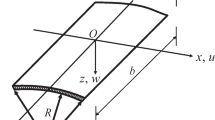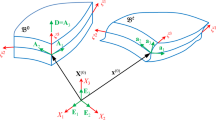Abstract
In this paper, a new bending model for composite laminated shells is proposed based on the refined zigzag theory. This new model is superior to the previous shell models based on the first-order shear deformation theory (FSDT) by introducing in-plane linear zigzag functions along the thickness direction, such that the shear correction coefficients can be omitted. In the present formulation, the bending equilibrium equations and boundary conditions of composite laminated shells are established by the virtual work principle. Without losing generality, Navier series solutions are used to describe the static properties of the composite laminated shells. In order to evaluate the effectiveness and performance of this new model, numerical examples are carried out to discuss the effect of the lamination schemes and geometric parameters on the static properties. In addition, the results are compared with the three-dimensional (3D) elastic theory and FSDT as well as the highly accurate theories in the literature to examine the accuracy. It is observed that the present model not only has the high accuracy of the high-order or other highly accurate models, but also has the intrinsic linear terms of the first-order models, such that it is very suitable for the future deducing finite element method to analyze the large-scale laminates with high computational efficiency. Therefore, the present new model can be a good candidate for engineering applications.




Similar content being viewed by others
References
Pagano, N.J.: Exact solutions for rectangular bidirectional composites and sandwich plates. J. Compos. Mater. 4, 20–34 (1970)
Ren, J.G.: Exact solutions for laminated cylindrical shells in cylindrical bending. Compos. Sci. Technol. 29, 169–187 (1987)
Wu, C.P., Liu, C.C.: Mixed finite-element analysis of thick doubly curved laminated shells. J. Aerosp. Eng. 8, 43–53 (1995)
Wu, C.P., Tarn, J.Q., Chi, S.M.: Three-dimensional analysis of doubly curved laminated shells. J. Eng. Mech. 122, 391–401 (1996)
Sheng, H.Y., Ye, J.Q.: A three-dimensional state space finite element solution for laminated composite cylindrical shells. Comput. Methods Appl. Mech. Eng. 192, 2441–2459 (2003)
Monge, J.C., Mantari, J.L., Arciniega, R.A.: Computational semi-analytical method for the 3D elasticity bending solution of laminated composite and sandwich doubly-curved shells. Eng. Struct. 221, 110938 (2020)
Guo, J.H., Chen, J.Y., Pan, E.: Analytical three-dimensional solutions of anisotropic multilayered composite plates with modified couple-stress effect. Compos. Struct. 153, 321–331 (2016)
Sun, T.Y., Guo, J.H., Zhang, X.Y.: Static deformation of a multilayered one-dimensional hexagonal quasicrystal plate with piezoelectric effect. Appl. Math. Mech. Engl. Ed. 39, 335–352 (2018)
Guo, J.H., Chen, J.Y., Pan, E.: A three-dimensional size-dependent layered model for simply-supported and functionally graded magnetoelectroelastic plates. Acta Mech. Solida Sin. 31, 652–671 (2018)
Kraus, H., Kalnins, A.: transient vibration of thin elastic shells. J. Acoust. Soc. Am. 38, 994–1002 (1965)
Donnell, L.H.: Stability of thin-walled tubes under torsion. In: Naca Tr. (1935)
Flügge, W.: Stresses in Shells: Stresses in Shells, (1960)
Zhang, G.Y., Gao, X.L., Littlefield, A.G.: A non-classical model for circular cylindrical thin shells incorporating microstructure and surface energy effects. Acta Mech. 232, 2225–2248 (2021)
Sanders, J.L.: An Improved First-Approximation Theory for Thin Shells. In: Nasa Rep, (1959)
Budiansky, B., Sanders, J.: On the “best” first-Order linear shell theory. Progress in Applied Mechanics, New York (1963)
Reissner, E.: The effect of transverse shear deformation on the bending of elastic plates. J. Appl. Mech. 23, 1–4 (1945)
Whitney, J.M., Pagano, N.J.: Shear deformation in heterogeneous anisotropic plates. J. Appl. Mech. 37, 1031–1036 (1970)
Zhang, G.Y., Gao, X.L.: A non-classical model for first-order shear deformation circular cylindrical thin shells incorporating microstructure and surface energy effects. Math. Mech. Solids 26, 1294–1319 (2021)
Hildebrand, F.B., Reissner, E., Thomas, G.B.: Notes on the foundations of the theory of small displacements of orthotropic shells. J. Int. Polit. Theory 37, 1107–1116 (1949)
Whitney, J.M., Sun, C.T.: A refined theory for laminated anisotropic cylindrical shells. J. Hefei Univ. Technol. 41, 383–396 (1987)
Reddy, J.N.: A Higher-Order Theory for Geometrically Nonlinear Analysis of Composite Laminates. In: Nasa Contractor Reports, (1987)
Love, A.E.H.: The small free vibrations and deformation of a thin elastic shell. Proc. R. Soc. Lond. 43, 352–353 (1887)
Yamaki, N. Simitses, G.J.: Elastic Stability of Circular Cylindrical Shells. North-Holland, (1984)
Iurlaro, L., Gherlone, M., Sciuva, M.D., Tessler, A.: Assessment of the refined zigzag theory for bending, vibration, and buckling of sandwich plates: a comparative study of different theories. Compos. Struct. 106, 777–792 (2013)
Matsunaga, H.: Vibration and stability of cross-ply laminated composite plates according to a global higher-order plate theory. Compos. Struct. 48, 231–244 (2000)
Matsunaga, H.: Vibration and stability of angle-ply laminated composite plates subjected to in-plane stresses. Int. J. Mech. Sci. 43, 1925–1944 (2001)
Matsunaga, H.: Assessment of a global higher-order deformation theory for laminated composite and sandwich plates. Compos. Struct. 56, 279–291 (2002)
Matsunaga, H.: Vibration and stability of cross-ply laminated composite shallow shells subjected to in-plane stresses. Compos. Struct. 78, 377–391 (2007)
Matsunaga, H.: Vibration and buckling of cross-ply laminated composite circular cylindrical shells according to a global higher-order theory. Int. J. Mech. Sci. 49, 1060–1075 (2007)
Lu, X., Liu, D.: An interlaminar shear stress continuity theory for both thin and thick composite laminates. J. Appl. Mech. 59, 502–509 (1992)
Sciuva, M.D.: A refined transverse shear deformation theory for multilayered anisotropic plates. Atti Accad. Sci. Torino 118, 279–295 (1984)
Sciuva, M.D.: Bending, vibration and buckling of simply supported thick multilayered orthotropic plates: an evaluation of a new displacement model. J. Sound Vib. 105, 425–442 (1986)
Sciuva, M.D.: Multilayered anisotropic plate models with continuous interlaminar stresses. Compos. Struct. 22, 149–167 (1992)
Sciuva, M.D.: A general quadrilateral multilayered plate element with continuous interlaminar stresses. Comput. Struct. 47, 91–105 (1993)
Sciuva, M.D.: Development of an anisotropic, multilayered, shear-deformable rectangular plate element. Comput. Struct. 21, 789–796 (1985)
Sciuva, M.D.: An improved shear-deformation theory for moderately thick multilayered anisotropic shells and plates. J. Appl. Mech. 54, 589–596 (1987)
Cho, M.: Efficient higher order composite plate theory for general lamination configurations. AIAA J. 31, 1299–1306 (1993)
Averill, R.C.: Static and dynamic response of moderately thick laminated beams with damage. Compos. Eng. 4, 381–395 (1994)
Averill, R.C., Yip, Y.C.: Development of simple, robust finite elements based on refined theories for thick laminated beams. Comput. Struct. 59, 529–546 (1996)
Icardi, U.: A three-dimensional zig-zag theory for analysis of thick laminated beams. Compos. Struct. 52, 123–135 (2001)
Icardi, U., Sola, F.: Development of an efficient zigzag model with variable representation of displacements across the thickness. J. Eng. Mech. 140, 531–541 (2014)
Tessler, A., Sciuva, M.D., Gherlone, M.: A consistent refinement of first-order shear deformation theory for laminated composite and sandwich plates using improved zigzag kinematics. J. Mech. Mater. Struct. 5, 341–367 (2010)
Tessler, A., Sciuva, M.D., Gherlone, M.: A refined zigzag beam theory for composite and sandwich beams. J. Compos. Mater. 43, 1051–1081 (2009)
Sciuva, M.D., Gherlone, M., Tessler, A.: A robust and consistent first-order zigzag theory for multilayered beams. Solid Mech. Appl. 168, 255–268 (2009)
Sciuva, M.D., Gherlone, M., Iurlaro, L., Tessler, A.: A class of higher-order C0 composite and sandwich beam elements based on the refined zigzag theory. Compos. Struct. 132, 784–803 (2015)
Tessler, A.: Refined zigzag theory for homogeneous, laminated composite, and sandwich beams derived from Reissner’s mixed variational principle. Meccanica (Milan) 50, 2621–2648 (2015)
Barut, A., Madenci, E., Tessler, A.: C0-continuous triangular plate element for laminated composite and sandwich plates using the {2,2}-Refined Zigzag Theory. Compos. Struct. 106, 835–853 (2013)
Tessler, A., Sciuva, M.D., Gherlone, M.: A homogeneous limit methodology and refinements of computationally efficient zigzag theory for homogeneous, laminated composite, and sandwich plates. Numer. Methods Partial Differ. Equ. 27, 208–229 (2011)
Iurlaro, L., Gherlone, M., Sciuva, M.D., Tessler, A.: Refined Zigzag Theory for laminated composite and sandwich plates derived from Reissner’s mixed variational theorem. Compos. Struct. 133, 809–817 (2015)
Reddy, J.N.: Mechanics of Laminated Composite Plates and Shells: Theory and Analysis. CRC Press (2004)
Mantari, J.L., Oktem, A.S., Soares, C.G.: Static and dynamic analysis of laminated composite and sandwich plates and shells by using a new higher-order shear deformation theory. Compos. Struct. 94, 37–49 (2012)
Reddy, J.N., Liu, C.F.: A higher-order shear deformation theory of laminated elastic shells. Int. J. Eng. Sci. 23, 319–330 (1985)
Karama, M., Afaq, K.S., Mistou, S.: A new theory for laminated composite plates: proceedings of the institution of mechanical engineers part L. J. Mater. Des. Appl. 223, 53–62 (2009)
Touratier, M.: An efficient standard plate theory. Int. J. Eng. Sci. 29, 901–916 (1991)
Khdeir, A.A., Reddy, J.N., Frederick, D.: A study of bending, vibration and buckling of cross-ply circular cylindrical shells with various shell theories. Int. J. Eng. Sci. 27, 1337–1351 (1989)
Author information
Authors and Affiliations
Corresponding authors
Ethics declarations
Conflict of interest
The authors declare that they have no known competing financial interests or personal relationships that could have appeared to influence the work reported in this paper.
Additional information
Publisher's Note
Springer Nature remains neutral with regard to jurisdictional claims in published maps and institutional affiliations.
Appendices
Appendix A
The refined zigzag functions are defined by piecewise linear functions [42]
The first layer starts at \(z_{(0)} = - h\) and the last layer ends at \(z_{(N)} = h.\)\(z_{(k)} = z_{(k - 1)} + 2h^{(k)}\), where \(2h^{(k)}\) represents the thickness of the kth layer.
In addition, the integrals of the slope functions \(\beta_{\alpha }^{(k)} {(}\alpha { = 1,2)}\) through the thickness disappear according to RZT [42], which yields
The average transverse shear strains can be expressed as [42]
Moreover, the transverse shear stresses can be expressed as
It is noted that \(\eta_{\alpha } = \gamma_{\alpha } - \psi_{\alpha } {\kern 1pt} (\alpha = 1,{\kern 1pt} {\kern 1pt} 2).\) The above constraints give rise to the following expressions [42]:
where
in which \(G_{1}\) and \(G_{2}\) can be regarded as the weighted average transverse shear stiffness coefficient of the each layer.
Substituting (A6) into (A4) gives the transverse shear stresses [42]
Bring (A5) into (A1) and get the zigzag functions [42]
Appendix B
The constitutive equation in the kth layer of an orthotropic shell can be shown as
where \({\varvec{T}}^{k}\) is the transform matrix and \({\varvec{M}}^{k}\) is the stiffness matrix in the local coordinate. In addition, \(m = \cos (\vartheta^{k} )\),\(n = \sin (\vartheta^{k} )\) and \(\vartheta^{k}\) is the angle of ply. Moreover, \(c_{11}^{(k)} = (1 - \nu_{23}^{(k)} \nu_{32}^{(k)} )/E_{2}^{(k)} E_{3}^{(k)} \Delta ,\) \(C_{22}^{(k)} = (1 - \nu_{13}^{(k)} \nu_{31}^{(k)} )/E_{1}^{(k)} E_{3}^{(k)} \Delta ,\)\(C_{12}^{(k)} = (\nu_{12}^{(k)} + \nu_{13}^{(k)} \nu_{32}^{(k)} )/E_{1}^{(k)} E_{3}^{(k)} \Delta ,\) \(C_{13}^{(k)} = (\nu_{31}^{(k)} + \nu_{21}^{(k)} \nu_{32}^{(k)} )/E_{2}^{(k)} E_{3}^{(k)} \Delta ,\)\(C_{23}^{(k)} = (\nu_{23}^{(k)} + \nu_{13}^{(k)} \nu_{21}^{(k)} )/E_{1}^{(k)} E_{3}^{(k)} \Delta ,\)\(C_{33}^{(k)} = (1 - \nu_{21}^{(k)} \nu_{12}^{(k)} )/E_{1}^{(k)} E_{2}^{(k)} \Delta ,\)\(C_{66}^{(k)} = G_{12}^{(k)} ,\)\(C_{44}^{(k)} = G_{13}^{(k)} ,\)\(C_{55}^{(k)} = G_{23}^{(k)} ,\)\(\nu_{21}^{(k)} { = }E_{2}^{(k)} \nu_{12}^{(k)} /E_{1}^{(k)} ,\)\(\nu_{31}^{(k)} { = }E_{3}^{(k)} \nu_{13}^{(k)} /E_{1}^{(k)} ,\)\(\nu_{32}^{(k)} { = }E_{3}^{(k)} \nu_{23}^{(k)} /E_{2}^{(k)}\) and \(\Delta = (1 - \nu_{12}^{(k)} \nu_{21}^{(k)} - \nu_{13}^{(k)} \nu_{31}^{(k)} - \nu_{23}^{(k)} \nu_{32}^{(k)} - \nu_{12}^{(k)} \nu_{23}^{(k)} \nu_{31}^{(k)} - \nu_{13}^{(k)} \nu_{21}^{(k)} \nu_{32}^{(k)} )/E_{1}^{(k)} E_{2}^{(k)} E_{3}^{(k)} .\)
\(E_{1}^{(k)}\),\(E_{2}^{(k)}\) and \(E_{3}^{(k)}\) are elastic modulus. \(G_{12}^{(k)}\),\(G_{13}^{(k)}\) and \(G_{23}^{(k)}\) are shear modulus. \(\nu_{12}^{(k)}\),\(\nu_{13}^{(k)}\) and \(\nu_{23}^{(k)}\) are Poisson ratios.
Appendix C
The components in (19) are listed as follows:
Rights and permissions
About this article
Cite this article
Gao, Y., Zhang, H., Yang, W. et al. A new bending model for composite laminated shells based on the refined zigzag theory. Arch Appl Mech 92, 2899–2915 (2022). https://doi.org/10.1007/s00419-022-02210-5
Received:
Accepted:
Published:
Issue Date:
DOI: https://doi.org/10.1007/s00419-022-02210-5




